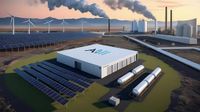The AI Revolution's energy demands are introducing challenges for power infrastructure and energy providers. As artificial intelligence (AI) continues to evolve, the surge in energy consumption is raising critical questions among industry leaders about future sustainability.
AI data centers, often considered the backbone of AI technology, now consume up to 50 times more electricity per square foot than traditional office spaces. This astonishing shift is driving a projected 55% increase in power demand in the United States over the next two decades, as every AI interaction consumes tenfold the energy of a typical internet search.
As renewable energy sources contribute to sustainability efforts, their inconsistent nature leads to concerns about sufficient energy supply. This reality underscores the vital role of natural gas as a reliable alternative to meet the relentless energy demands that AI technology demands.
To address this critical juncture, Chevron has initiated significant partnerships to foster a sustainable energy supply for AI data centers. Collaborating with Engine No. 1 and GE Vernova, the company aims to roll out scalable, gas-fired power solutions that could ultimately add up to four gigawatts of energy capacity by 2030, enough to power about 3.5 million homes across the nation.
In a recent statement, Daniel Droog, Chevron's vice president of power solutions, expressed enthusiasm for addressing the unprecedented demand from data centers: “The buoyant demand from data centers hungry for dependable energy sources presents a unique opportunity for Chevron.” This endeavor not only reinforces Chevron's business strategy but also establishes the company as a pivotal player in the quest for sustainable energy solutions.
Chevron’s strategy includes the incorporation of carbon capture technology to mitigate environmental impacts, alongside exploring potential synergies with renewable energy sources. The imminent rise in AI-driven power demands offers Chevron not only a business opportunity but also a defining role in shaping the energy landscape for future innovations.
As Chevron’s construction plans unfold, permitting, and engineering processes are already underway for several prospective sites where energy plants can be established. These new power plants promise to deliver consistent energy supplies while providing stability against fluctuating gas market prices.
Moreover, as the AI market continues to burgeon, the implications for energy management in this space are significant. Experts anticipate that navigating the intersection of energy consumption and AI technology will require innovative solutions, including the implementation of advanced energy storage solutions, smart grid technologies, and an unwavering commitment to efficiency.
Industry forecasts indicate that as the demand for AI-driven solutions intensifies, the energy sector must adapt and evolve. Chevron's proactive strategies exemplify how energy providers can meet these challenges head-on, establishing an operational blueprint for successfully leveraging traditional energy sources to power the technological advancements of tomorrow.
With the impending AI-powered surge in energy consumption, it is crucial for energy providers to understand the evolving dynamics and innovatively respond to the challenges posed by this new landscape. The successful integration of AI, energy management systems, and renewable energy can yield advanced solutions for a sustainable future.
As Chevron embarks on this essential journey, the quest to balance AI’s explosive growth with environmental responsibility remains paramount. By establishing scalable, gas-fired energy solutions, Chevron is leading the charge toward securing a future where AI and energy resources coalesce harmoniously, paving the way for groundbreaking innovations in an evolving digital age.


